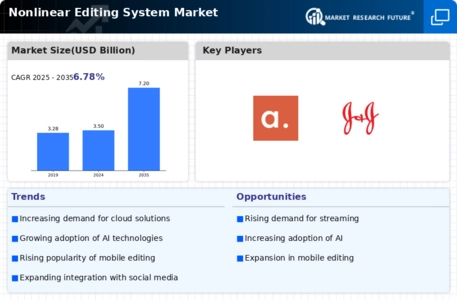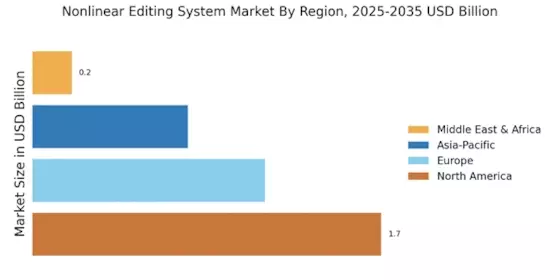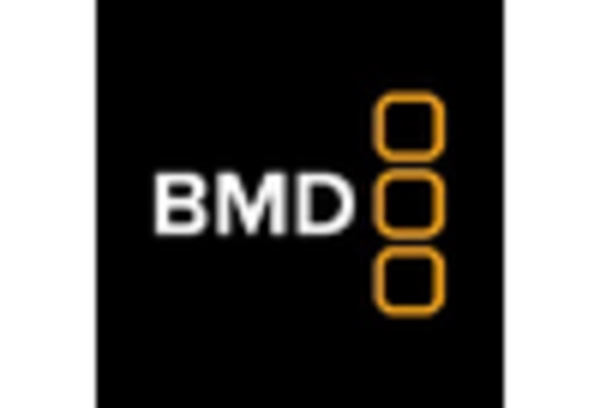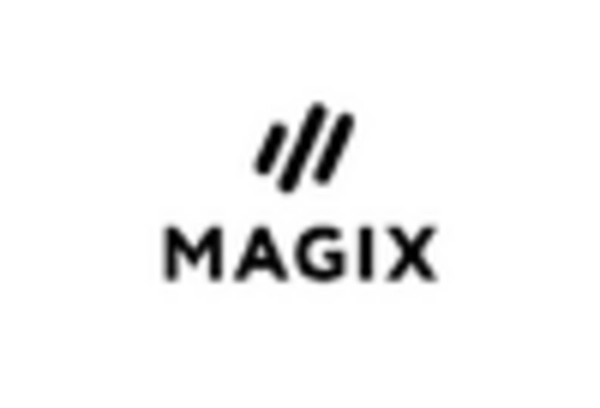Advancements in Video Technology
The Nonlinear Editing System Market is experiencing a surge in demand due to rapid advancements in video technology. Innovations such as 4K and 8K resolution, high dynamic range (HDR), and immersive audio formats are reshaping content creation. As these technologies become more accessible, content creators are increasingly seeking sophisticated editing solutions that can handle high-quality footage. This trend is reflected in the market, which is projected to grow at a compound annual growth rate (CAGR) of approximately 10% over the next five years. The need for advanced editing capabilities to accommodate these high-resolution formats is likely to drive the adoption of nonlinear editing systems, as professionals strive to enhance the visual quality of their productions.
Increased Demand for Video Content
The Nonlinear Editing System Market is significantly influenced by the escalating demand for video content across various platforms. With the proliferation of social media, streaming services, and online education, the need for high-quality video production has never been greater. According to recent statistics, video content is expected to account for over 80% of all internet traffic by 2025. This growing appetite for engaging video content compels creators to invest in advanced nonlinear editing systems that facilitate efficient editing processes. As a result, the market is likely to witness a robust expansion, driven by the necessity for tools that can streamline video production workflows and enhance content quality.
Integration of Artificial Intelligence
The Nonlinear Editing System Market is increasingly shaped by the integration of artificial intelligence (AI) technologies. AI-driven features, such as automated editing, scene recognition, and content tagging, are enhancing the efficiency of the editing process. These innovations allow editors to focus on creative aspects while AI handles repetitive tasks, thereby streamlining workflows. The market is projected to benefit from this trend, as more nonlinear editing systems incorporate AI functionalities to meet the evolving needs of content creators. This integration not only improves productivity but also enables users to produce high-quality content in shorter timeframes, potentially transforming the editing landscape.
Emergence of Remote Collaboration Tools
The Nonlinear Editing System Market is adapting to the increasing trend of remote collaboration among content creators. As teams become more geographically dispersed, the demand for editing systems that support collaborative workflows is rising. Solutions that enable multiple users to work on a project simultaneously, regardless of location, are becoming essential. This shift is supported by the integration of cloud-based editing platforms, which allow for real-time collaboration and feedback. The market is expected to respond positively to this trend, as more professionals seek nonlinear editing systems that facilitate seamless teamwork and enhance productivity in a remote working environment.
Growing Popularity of User-Generated Content
The Nonlinear Editing System Market is witnessing a notable impact from the rising popularity of user-generated content (UGC). As individuals and small creators gain access to advanced editing tools, the landscape of content creation is evolving. Platforms that encourage UGC, such as TikTok and Instagram, are driving the need for intuitive nonlinear editing systems that cater to novice editors. This democratization of content creation is likely to expand the market, as more users seek affordable and user-friendly editing solutions. The trend suggests a shift towards systems that not only provide professional-grade features but also prioritize ease of use for everyday creators.


















Leave a Comment